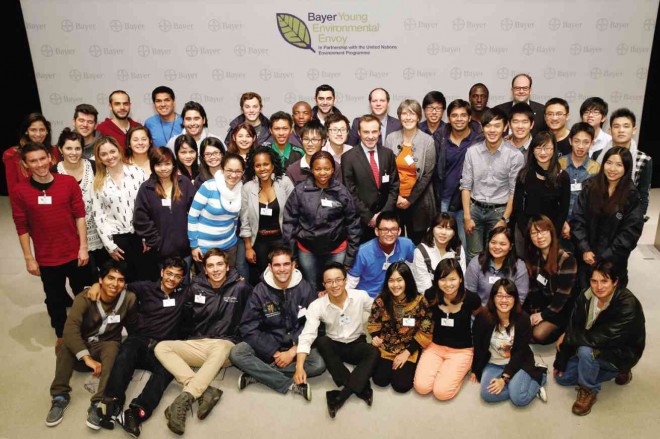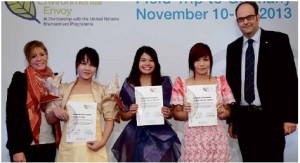‘Haiyan’ offers Filipinos a chance to showcase ingenuity

BAYER Young Environmental Envoys from 19 countries, with Condon (center), after a panel discussion on adequate and healthy food supply for the global population PHOTOS COURTESY OF BAYER PHILIPPINES
Supertyphoon “Haiyan” (local name: “Yolanda”) may have wiped out acres of rice fields, uprooted thousands of trees and destroyed millions of pesos worth of crops.
But for a young environmental envoy, the devastation caused by one of the strongest typhoons ever recorded can only bring out the ingenuity of Filipinos.
“The supertyphoon may have affected our food security, but I believe the Filipino mind, brilliant as it always is, can find efficient ways to adapt to events such as this,” said Ma-an Jane Diamos, a senior at the University of the Philippines Manila.
Diamos and fellow envoys Justine Win M. Cañete of John B. Lacson Foundation Maritime University in Iloilo City and Glykie Cañete of the University of Cebu Banilad have just returned from a weeklong educational field trip to Bayer facilities and environmentally relevant institutions in Leverkusen, Germany.
The Filipinos joined 45 other Bayer Young Environmental Envoys (BYEE) from 19 countries in Latin America, Africa and Asia in discussions, lectures and workshops on sustainable ways to manage food supplies.
Article continues after this advertisementBayer, a pharmaceutical, crop protection and advance materials development firm, and United Nations Environment Program (UNEP) have been organizing annually since 1998 the youth environmental program as part of their global partnership.
Article continues after this advertisementFood wastage
From the BYEE panel discussions, Diamos learned that the UN Food and Agriculture Organization estimated that 32 percent of all food was lost or wasted in 2009.
“The occurrence of Supertyphoon Yolanda has aggravated food loss in our country. It has undoubtedly brought light to the severity of the problem [of wastage] and stirred fears of famine, as the storm destroyed vast acres of farmland,” she said.
The biology student said the Philippines should formulate clear and long-term climate mitigation plans.

GLYKIE Cañete (second from left), Justine Win Cañete and Diamos receive their certificates from UNEP’s Geraldine Deblon and Michael Preuss, Bayer’s head of corporate policy and media relations.
“The most efficient strategy to help us get through this crisis is to design frameworks that emphasize adaptation to current climatic conditions,” she added.
Glykie did not miss the opportunity to ask the Bayer panel how to solve the country’s problem.
“They said they actually offered solutions such as seed treatment like Gaucho,” the tourism student said. “This may sound like a commercial endorsement but this can … protect young plants so they can survive harsh weather,” she added.
Justine said it was time for the Philippines to adopt this technology as natural disasters were becoming more common and severe.
An information technology student, Justine said that despite differences in cultures and beliefs, the delegates had one thing in common—“passion for environmental initiatives and raising awareness [of ecological issues].”
Bayer CropScience chief executive officer Liam Condon said he was impressed by the envoys’ level of knowledge and commitment.
“Young people who get involved in the urgent issue of securing an adequate and healthy food supply for the global population deserve high recognition and support,” Condon said in a statement.
James Lomax, UNEP program officer, Agri-Food, also commended the participants.
“The commitment demonstrated by these young people is exemplary, and this exchange on an international level gives them a tremendous opportunity to expand their horizons and develop networked solutions,” Lomax said.
Cooperation is key
Heike Ostermann, Gesellschaft für Internationale Zusammenarbeit (GIZ) GmbH adviser for sustainable agriculture, said development cooperation was “key to … minimizing food losses and food waste and raising efficiency for sustainable food production.”
The Philippine delegates did not only learn from the experts but from their fellow envoys, too.
Five envoys received the Young Environmental Leader Award. Kenya’s Wallace Chwala received 1,000 euros for his novel composting system. He reused plastic bags, which increased the temperature and reduced the time it took to compost organic waste.
Felipe dos Santos Machado from Brazil and Kevin Lee Jia Le from Singapore used garbage to develop new and energy-efficient construction materials. Claudia Maria Escobar Prado from Costa Rica researched a sustainable alternative to silicium solar cells. Soumyajit Paul from India created a light-transmitting concrete through the incorporation of optical fibers. They received 500 euros each.
Diamos said “the envoys from other countries were all open to and excited about intellectual discussions … the entire conference was packed with informative, timely dialogues.”
In a conversation with Chile’s envoy, a biochemist, she learned his country allocated enough money for research.
“Sometimes they go on expeditions to Antarctica to study its microbiology. They were even able to isolate bacteria that were capable of degrading petroleum,” she said.
Diamos said it was “unfortunate” that the educational trip lasted only a week. “But I believe we maximized our participation in every activity and absorbed everything to be learned in the convention,” the young scientist, who presented a study on plastic-reducing bacteria, added.
For Glykie, the trip to Germany helped her compare methods for mitigating climate change between the Philippines and other countries.
“Being environmentally aware is not enough … involvement and cooperation [are also needed]. And that is one of the factors that I haven’t seen much of among Filipinos,” she said.
Glykie, who produced an environmental show that taught children to plant and recycle for her K to Green Project, said she felt privileged to be chosen as an envoy and to be “an instrument to start and spread change” in the country.